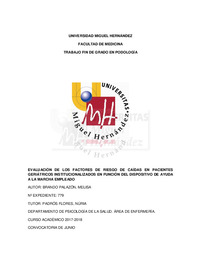Por favor, use este identificador para citar o enlazar este ítem:
https://hdl.handle.net/11000/25923Registro completo de metadatos
| Campo DC | Valor | Lengua/Idioma |
|---|---|---|
| dc.contributor.advisor | Padrós Flores, Nuria | - |
| dc.contributor.author | Brando Palazón, Melisa | - |
| dc.contributor.other | Departamentos de la UMH::Psicología de la Salud | es_ES |
| dc.date.accessioned | 2022-02-22T08:14:50Z | - |
| dc.date.available | 2022-02-22T08:14:50Z | - |
| dc.date.created | 2018-06-21 | - |
| dc.identifier.uri | http://hdl.handle.net/11000/25923 | - |
| dc.description.abstract | Introducción: Las caídas representan uno de los grandes síndromes geriátricos y un importante problema de salud por su frecuencia y graves complicaciones asociadas. En pacientes institucionalizados el riesgo de caídas aumenta, lo que incrementa los costos de los tratamientos en concepto de valoraciones médicas, personal para cuidado y tiempo para la recuperación. Además, suponen un problema real, siendo considerado un indicador de calidad asistencial, puesto que cuanto mayor sean las incidencias de caídas, menor será la calidad de la asistencia prestada y viceversa. Objetivos: Evaluar la relación entre el uso de dispositivos para la marcha utilizado por personas en edad geriátrica institucionalizadas y su riesgo de caídas. Material y métodos: 26 residentes geriátricos de la residencia Obispo Javier Azagra en el Palmar (Murcia) fueron seleccionados entre los 120 residentes totales pues cumplían los criterios de inclusión y exclusión. Se utilizó la escala de Tinetti para evaluar el riesgo de caídas y un cuestionario diseñado con 14 preguntas donde se recogen los principales factores de riesgo relacionados con las caídas en ancianos. Resultados: el 65,4% de los residentes (17 residentes) no utilizan dispositivo, el 26,9% (7 residentes) utiliza andador y el 7,7% (2 residentes) usan bastón. Al relacionar la variable dispositivo de ayuda para la marcha y puntuación global de la escala de Tinetti, se obtienen resultados estadísticamente significativos, es decir, existe relación entre el uso de dispositivo de ayuda para la marcha y el riesgo de sufrir una caída, siendo los que usan andador los que obtienen puntuaciones más bajas y por tanto tienen mayor riesgo de caídas que el resto. En el resto de resultados no se obtiene datos estadísticamente significativos. Conclusiones: Existen diferencias entre el riesgo de caídas en pacientes institucionalizados que utilizan diferentes dispositivos de ayuda para la marcha en nuestra población estudiada siendo los que usan andador aquellos que obtienen puntuaciones promedias más bajas en la escala de Tinetti. No podemos afirmar que hay relación entre el resto de factores relacionados con las caídas, con el riesgo de caídas en nuestra población de estudio. | es_ES |
| dc.description.abstract | Introduction: The falls represent one of the great geriatric syndromes and an important health problem due to their frequency and serious associated complications. In institutionalised patients the risk of falls increases, which in turn generates increments in costs for medical assessments, treatments, health-care staff and time for recovery. In addition, they represent a real problem, being considered an indicator of quality of care, since the greater the incidences of falls, the lower the quality of the assistance provided and vice versa. Objectives: To evaluate the relationship between the use of walking devices used by institutionalised geriatric people and the risk of falls. Material and methods: 26 geriatric residents of the Obispo Javier Azagra residence in El Palmar (Murcia) were selected among the 120 total residents who met the inclusion and exclusion criteria. The Tinetti scale was used to assess the risk of falls and a questionnaire designed with 14 questions that includes the main risk factors related to falls in the elderly. Results: 65.4% of residents (17 residents) do not use a device, 26.9% (7 residents) use a walker and 7.7% (2 residents) use a cane. By relating the variable walking aids and overall score of the Tinetti scale, statistically significant results are obtained, that is, there is a relationship between the use of a walking aid and the risk of falling, being the who use walker those who obtain lower scores and therefore have higher risk of falls than the rest. In the rest of the results, no statistically significant data are obtained. Conclusions: There are differences between the risk of falls in institutionalised patients who use different walking aids in our study population. Those who use walkers obtain lower average scores on the Tinetti scale. We cannot affirm that there is a relationship between the rest of factors related to falls, and the risk of falls in our study population. | es_ES |
| dc.format | application/pdf | es_ES |
| dc.format.extent | 42 | es_ES |
| dc.language.iso | spa | es_ES |
| dc.publisher | Universidad Miguel Hernández | es_ES |
| dc.rights | info:eu-repo/semantics/openAccess | es_ES |
| dc.rights | Attribution-NonCommercial-NoDerivatives 4.0 Internacional | * |
| dc.rights.uri | http://creativecommons.org/licenses/by-nc-nd/4.0/ | * |
| dc.subject | caídas | es_ES |
| dc.subject | ancianos | es_ES |
| dc.subject | prevención | es_ES |
| dc.subject | pacientes institucionalizados | es_ES |
| dc.subject.other | CDU::6 - Ciencias aplicadas | es_ES |
| dc.title | Evaluación de los factores de riesgo de caídas en pacientes geriátricos institucionalizados en función del dispositivo de ayuda a la marcha empleado | es_ES |
| dc.type | info:eu-repo/semantics/bachelorThesis | es_ES |

Ver/Abrir:
779_BRANDO_PALAZÓN_MELISA.pdf
1,57 MB
Adobe PDF
Compartir:
 La licencia se describe como: Atribución-NonComercial-NoDerivada 4.0 Internacional.
La licencia se describe como: Atribución-NonComercial-NoDerivada 4.0 Internacional.
.png)